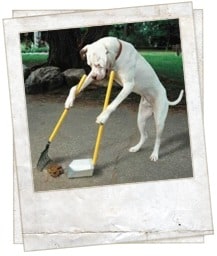 Taking on an older dog can seem like a challenge to many people, especially when it comes to potty training a dog. For this reason a lot of older dogs get overlooked and forgotten in rescue centers.
Taking on an older dog can seem like a challenge to many people, especially when it comes to potty training a dog. For this reason a lot of older dogs get overlooked and forgotten in rescue centers.
However, just because a dog is older does not mean that it is going to be many times harder to train than a puppy. Puppies learn quickly because you are teaching them the habits that you want them to continue, usually for the rest of their lives.
The challenge with an older dog lies in the breaking of the habits already formed and replacing them with the new ones.
One of the most off-putting habits for owners or potential owners to deal with is the potty training of older dogs. This is usually viewed as a habit that is very hard to break, but in many cases it is no as hard as first thought.
Potty training a dog of any age, requires three key things:
• Patience
• Perseverance
• Positivity
These are essential and you cannot train a dog without them.
Dog obedience training is highly recommended for older dogs just as much as puppies. This can help with aggression, social interaction and focus. Ask the experts for dog training techniques that can be used in the potty training process if you need any extra advice or clarification on any points.
If you have been looking for information online or been browsing in shops you may have come across the indoor dog potty.
This is a contraption that is basically an expensive pet pad. It is non-disposable and reusable. A pet potty may seem like a bit of an extreme purchase but for potty training a dog that is elderly, perhaps without the aid of a crate, or for dogs who will be left alone for longer periods of time, it will save on clearing up and the unpleasantness of finding mess hidden behind doorways or in shoes.
The best way to potty train an older dog is almost identical to house breaking a puppy. The following tips will help:
1. Keep your dog under close supervision. If your dog habitually goes in the house and will avoid going outside at all costs this is an essential step and if need be section off parts of your home to ensure you can keep an eye on him at all times
2. When potty training a dog, never, ever, ever get mad at your dog for eliminating inside. They have no concept of right and wrong and that ‘guilty look’ he does when you come home, that immediately alerts you to the poop you are guaranteed to find, is because your dog knows that when you come home to find a mess you get mad.
He will never, ever, no matter how much you shout or rub his nose in it, link your anger to the actual act of making the mess. He will only understand that you are mad at finding it, not at him making it
3. A full grown dog may be harder to manoeuvre outside than a puppy and once your dog has assumed the position, and you need to get him outside quickly, he isn’t going to want to move. Invest in a can of compressed air and, without looking at him, spray it near enough to distract him. Take him outside immediately and wait until he eliminates
4. Doesn’t want to go outside and waits until you get in the house? Take him outside for five minutes and when he doesn’t relieve himself take him back in only to immediately go back outside. Repeat this for as long as it takes to get a positive result
5. Take your dog outside ten minutes after each meal and when awaking from a nap
6. Use a potty training chart to keep track of good bouts of elimination and the not so good times and watch out for patterns
Potty training a dog of any age is not difficult, but it does take patience, consistency, and perseverance, especially with older dogs. However the end reward is well worth the effort.
For more information about Dog Potty Training, check out the highly recommended Complete 7 Day Potty Training Guide today!

